Key takeaways:
- Flexible typography enhances readability and user experience across different devices, fostering engagement and retention.
- Using relative units like ems or percentages promotes inclusivity, accommodating users with visual impairments.
- Establishing a clear typographic hierarchy guides user attention and emphasizes important information effectively.
- Tools like CSS frameworks and responsive font sizing are essential for implementing adaptive typography in web design.

Understanding flexible typography
Flexible typography is all about adapting text to different screen sizes and contexts, ensuring that the content looks great on any device. I remember the first time I experimented with responsive font sizes. I was amazed at how adjusting the typography transformed the user experience on my website, making it more readable and visually appealing across both mobile and desktop platforms.
One of my favorite techniques is using relative units like ems or percentages instead of fixed pixels. This approach not only empowers the design to be more fluid but also helps in accommodating users who might have visual impairments. Isn’t it fascinating how a simple change in measurement can create a more inclusive space for everyone?
When I think about flexibility in typography, I also consider the emotional impact of font choices. Just like how our tone of voice changes in a conversation, the right typeface can evoke feelings and set the mood of a website. Have you ever landed on a site and instantly felt the brand’s personality through its typography? That’s the magic of flexible typography at work, creating a seamless connection between form and function.
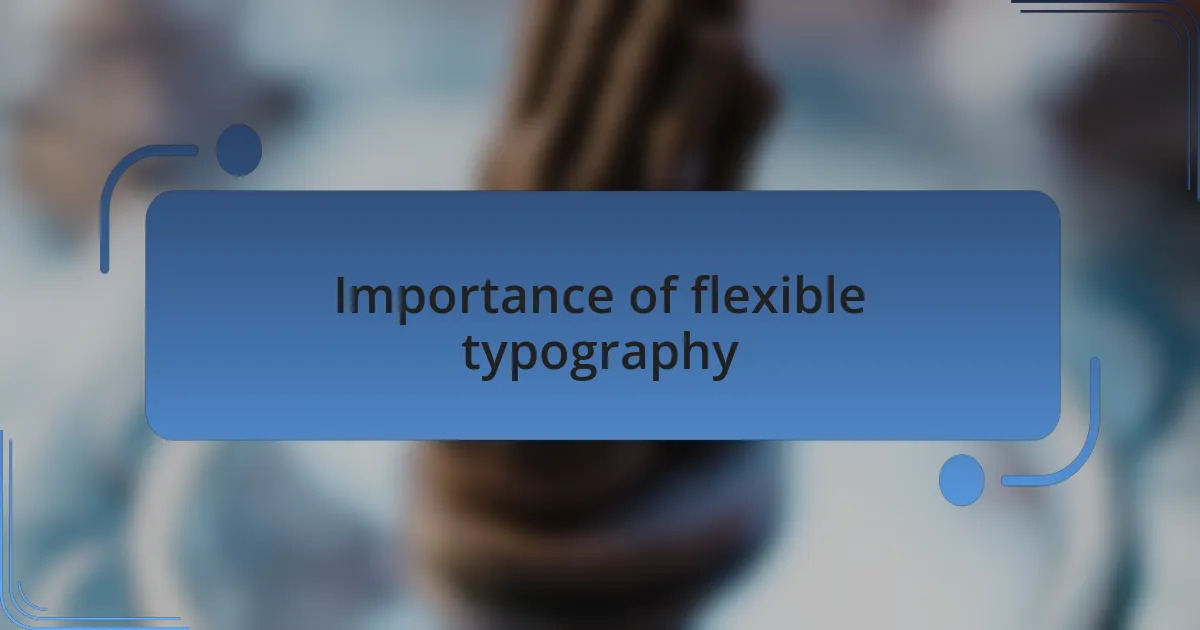
Importance of flexible typography
The significance of flexible typography cannot be overstated. I recall a project where the website’s text appeared cramped on mobile devices, making it almost unreadable. After implementing flexible typography, the content aligned beautifully with each screen size, enhancing user retention and ensuring that the message was communicated effectively no matter where it was viewed.
When I reflect on my experiences, I realize that flexible typography shapes how users perceive a brand. A well-structured typographic hierarchy can guide attention and prioritize information. Have you ever landed on a site and been instantly drawn to a headline that just popped? That’s the power of thoughtfully adapted typography—it can influence decisions and drive engagement.
Moreover, flexible typography enhances accessibility, a crucial aspect in today’s web design. I once collaborated with a client who emphasized reaching a broader audience, including individuals with visual impairments. By switching to scalable fonts and improving line spacing, we not only made the content more comfortable to read but also created a welcoming environment for all users. This experience underscored for me that great design truly respects diversity.
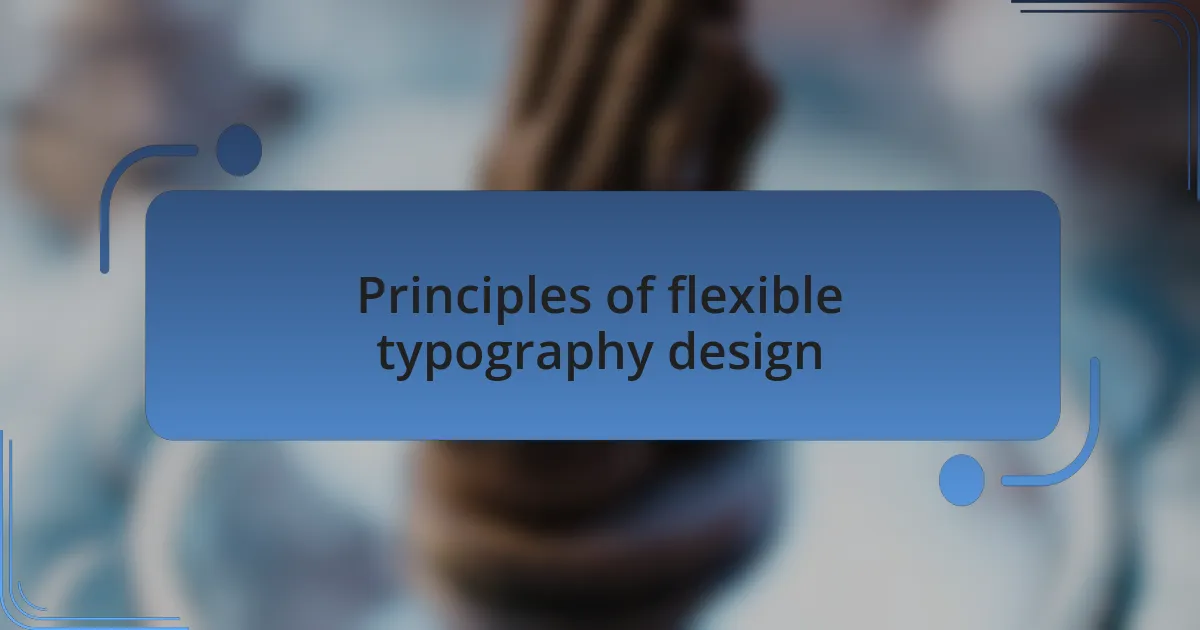
Principles of flexible typography design
When considering flexible typography design, I’ve found that adaptability is key. I once worked on a landing page where the font size had to shift depending on the user’s device. At first, the text seemed too small on desktops and overwhelming on phones, but after fine-tuning those sizes based on screen dimensions, the readability improved dramatically. Have you ever squinted at your screen, trying to decipher tiny fonts? Adapting typography helps avoid that frustration.
Another principle I cherish is maintaining a clear hierarchy through font weights and styles. I remember a website overhaul where I completely restructured the text hierarchy to better reflect the brand’s message. By using bold headlines to draw attention and lighter weights for body text, not only did the design breathe, but it also guided visitors effortlessly through the content. It made me think—how often do we overlook the subtle cues that typography provides about what’s important?
Consistency is also a fundamental aspect of flexible typography that I hold dear. During a recent project for a non-profit, we needed to create a sense of unity across various pages. By standardizing font families and sizes, I noticed how much more professional the site felt. It struck me that even small details, like keeping typographic choices uniform, can significantly enhance a user’s trust in a brand. This revelation left me pondering—what consistent elements have you noticed in the sites that inspire you?
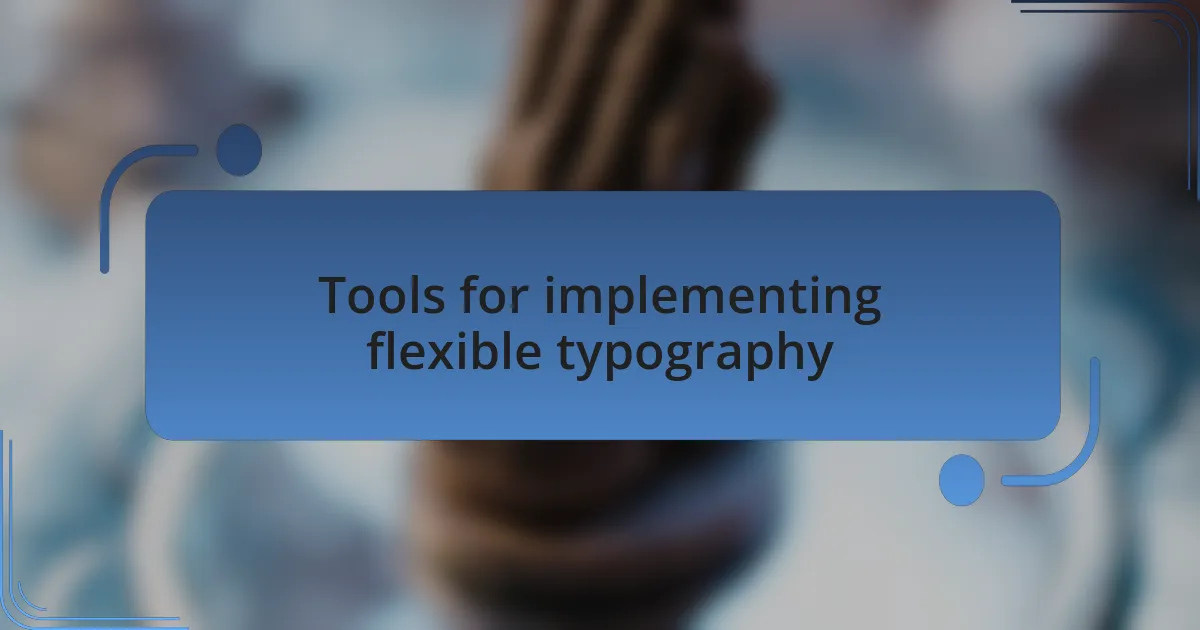
Tools for implementing flexible typography
When it comes to implementing flexible typography, there are several tools I’ve found invaluable. I often rely on CSS frameworks like Bootstrap or Tailwind CSS, which provide utility classes for responsive typography. Once, while redesigning a blog, I discovered how easily these frameworks allowed me to adjust font sizes relative to the viewport. Have you ever marveled at how seamlessly a website adapts as you resize your browser window? It’s the magic of responsive design in action.
Another tool I frequently use is CSS Grid and Flexbox. These layout systems empower me to create flexible text containers that automatically adjust based on the screen size. For instance, during a recent e-commerce project, I implemented a responsive card layout that gracefully rearranged text and images depending on the device. The result? A visually appealing and user-friendly experience. Can you picture how pleasing it is to see your content dynamically shift and maintain clarity across devices?
Finally, I can’t underscore the importance of using tools like Google Fonts or Adobe Fonts. They not only offer a wide variety of typefaces but also allow me to implement responsive font sizing with ease. I once experimented with different font pairings for a client’s site, and using these resources, I found just the right combination to evoke the brand’s essence. It made me wonder—how often do we consider how a font choice can influence the overall tone of our messaging? The right typography can transform the voice of your content entirely.
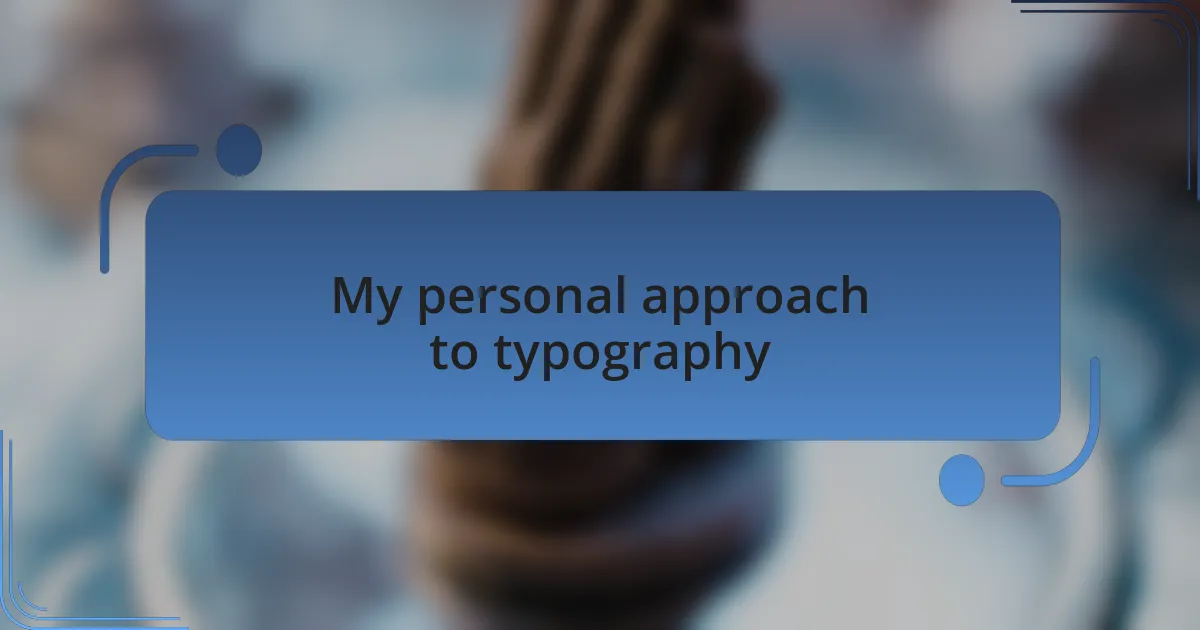
My personal approach to typography
My personal approach to typography centers around the idea of harmony and balance. I believe that typography should not only convey information but also evoke emotion. A few years ago, while crafting a website for a local artist, I chose a hand-lettered font to reflect their unique style. It thrilled me to see how the typeface captivated visitors, making them feel connected to the artist’s work. Have you ever encountered a font that made you feel something special?
I also prioritize legibility above all else. I recall a challenging project where I had to design a mobile-friendly newsletter. Initially, I went for a trendy font that looked great but was hard to read on smaller screens. After realizing my mistake, I switched to a simpler sans-serif font, and the improvement was astonishing. Clarity in typography can often be the difference between engaging your audience and losing them. Isn’t it fascinating how a simple change can alter the entire user experience?
Finally, I’m a firm believer in the power of whitespace. It allows typography to breathe, offering a more pleasant reading experience. I once worked on a corporate website where I deliberately increased line spacing and margins. The feedback was overwhelmingly positive — users mentioned how the text felt less crowded and easier to digest. It got me thinking: how often do we underestimate the impact of negative space on our content’s appeal?
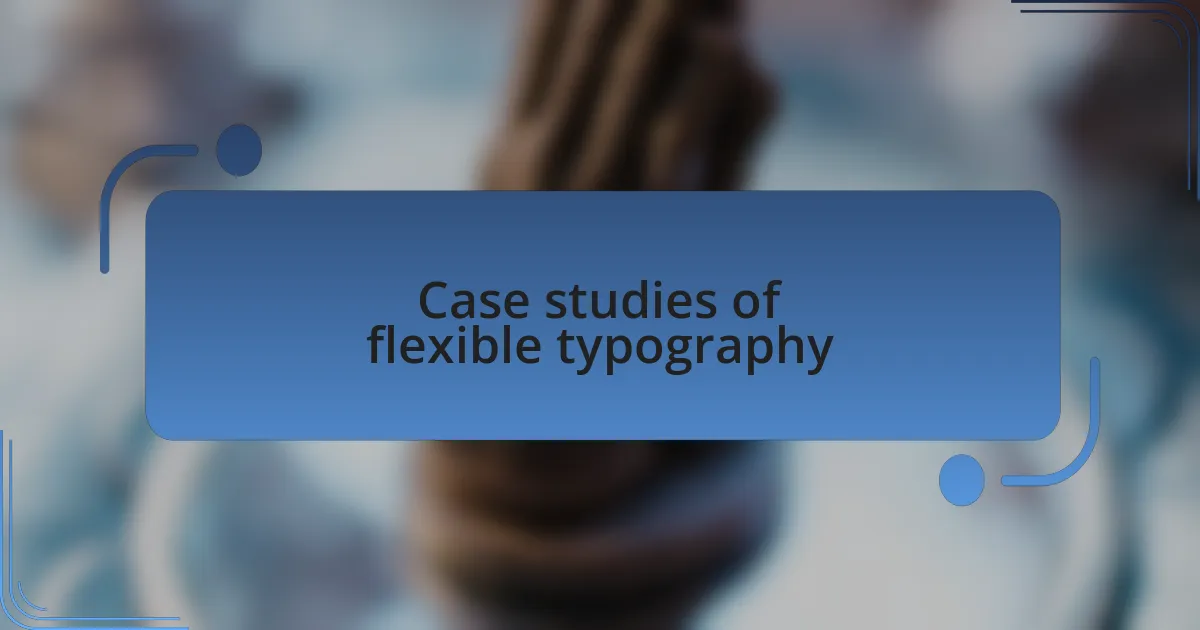
Case studies of flexible typography
I remember a project where I implemented a flexible typography system for an e-commerce website. I used a responsive font size that adjusted based on the user’s device, ensuring that product descriptions were just as readable on a smartphone as they were on a desktop. The result? An increase in conversion rates as users found it simpler to browse and purchase items without straining their eyes. Have you ever experienced the frustration of squinting at a tiny font on your phone?
In another instance, I experimented with variable fonts for a startup’s landing page. This innovative approach allowed me to subtly adjust weight and styles based on user interactions. I was amazed to see how a playful change in typography could enhance user engagement, making the text not only aesthetically pleasing but also dynamic. It got me thinking: how often do we overlook the potential of typography to actively draw users into an experience?
One of my favorite experiences was designing a blog for a passionate traveler who wanted a whimsical feel. I chose a mix of serif and script fonts, adapting sizes and weights to create a visual hierarchy that mirrored the rhythm of travel stories. The feedback was moving, with readers expressing how the typography seemed to transport them to different places. Isn’t it powerful how the right type can tell a story all on its own?
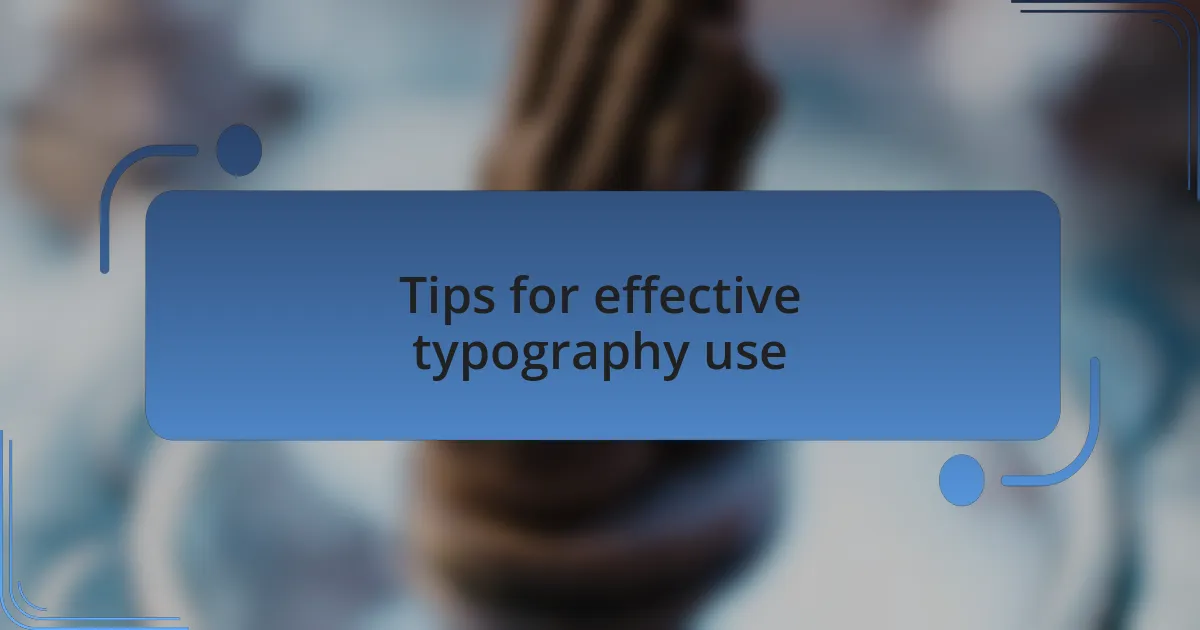
Tips for effective typography use
When it comes to effective typography, one of my go-to tips is to prioritize readability. On a recent project, I adjusted line heights and letter spacing to create a comfortable reading experience. It was fascinating to watch how a small change significantly reduced user fatigue and kept visitors engaged longer. Have you ever tried reading a crowded chunk of text? It can discourage even the most interested reader.
Another valuable approach I’ve learned is to establish a clear typographic hierarchy. For instance, while designing a newsletter, I used varying font sizes for headings, subheadings, and body text. This method allowed me to guide readers effortlessly through the content, making important information stand out. I often wonder how many designers neglect this simple yet crucial aspect—doesn’t every piece of content deserve to shine?
Finally, don’t underestimate the power of contrast. I remember creating a promotional banner where I paired a bold, sans-serif font with a delicate script. The contrast not only drew attention but also evoked excitement about the event. It’s interesting to think about how our eyes naturally gravitate toward differences—how else can we use this principle to make our typography more compelling?